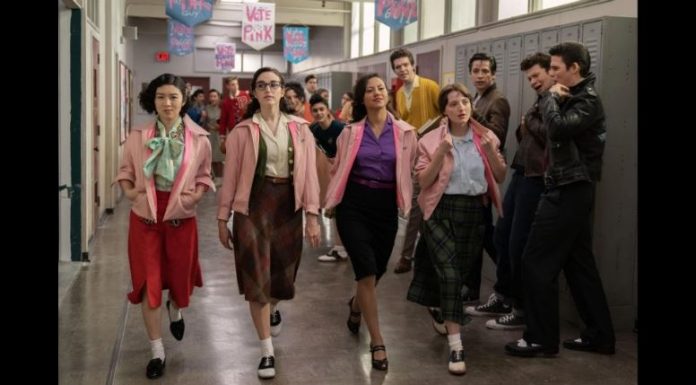
LOS ANGELES, April 6 (UPI) — The cast of Grease: Rise of the Pink Ladies, premiering Thursday on Paramount+, said the prequel tackles social issues the stage show and movie could not address.
Marisa Davila, Cheyenne Wells, Tricia Fukuhara and Ari Notartomaso play the founding members of Rydell High’s girl gang in 1954. Latina Olivia (Wells) faces discrimination for wearing the same dress as a White classmate.
“Latina women in general are very sexualized because of their bodies and their body shapes,” Wells told UPI in a Zoom interview. “Because her outfit is tight and she’s a little thicker, [teachers say] she’s in the wrong but not the other person.”
Racism impacts several characters in Rise of the Pink Ladies. Jane (Davila) is also half Puerto Rican, but her family emphasizes their Italian half to fit in.
Hazel (Shanel Bailey) is one of the only Black students at Rydell. While Hazel also copes with racism of the ’50s, Bailey said she was happy Rise of the Pink Ladies shows there is more to Hazel than her struggle.
“It’s not the only thing that we focus on and it’s not traumatic,” Bailey said. “I love that we get to see Hazel’s joy. I just want to see that girl smile and know that there are hardships out there but I want to see her dance.”
Cynthia (Notartomaso) wants to join the T-Birds, the male auto racing gang of whom Danny (John Travolta) was the leader in the movies. Notartomaso, who identifies as gender nonconforming nonbinary trans, said Cynthia might have been nonbinary too.
“Queerness, gender nonconformity and transness throughout time hasn’t always been exactly the same,” Notartomaso said. “All of us are a product of the culture that we live in, but it is really special to be able to tell that story of what it may have been like in the 1950s.”
Jane faces a double standard about sexual activity. When her boyfriend, Buddy (Jason Schmidt), spreads rumors that they slept together, Buddy is celebrated while Jane is condemned, but Jane refuses to play into those gender dynamics.
“Not at one point does she ever resort to being like, ‘Maybe I should change myself,'” Davila said. “She’d rather be lost and alone and so confused.”
One of the Rydell girls fueling the rumor mill against Jane is Susan (Madison Thompson). Thompson said Susan is a product of the ’50s patriarchy, but will reveal more complex motivations as the series goes on.
“She has a lot to learn from the Pink Ladies and the change that they’re bringing to Rydell,” Thompson said. “But I think the Pink Ladies could learn a thing or two from her too.”
Nancy (Fukuhara) designs the Pink Lady jackets for herself, Jane, Olivia and Cynthia to signify their rebellion against Rydell norms. The jackets recreate the wardrobe of the 1978 movie and its sequel.
Fukuhara said wardrobe fittings could last over 2 hours and welcomed the cast’s input.
“You’re just playing dress up and seeing what feels good and seeing what doesn’t,” Fukuhara said. “Trying that on and then seeing how things evolve and maybe we add a hat.”
When the Pink Ladies debut at Rydell, they strut down the halls. Since each pink jacket was tailored to the actor, they did not see their gang colors together until the day they filmed the scene.
“When we were doing it, it was quiet,” Wells said. “We did get the [cue] ‘Five, six, seven and walk.’ Then we were on our own.”
Davila said she agreed the debut of the Pink Ladies was more intimidating on set than it appears in the final cut.
“Imagine trying to walk down the hall badass and you could hear a pin drop,” Davila said.



